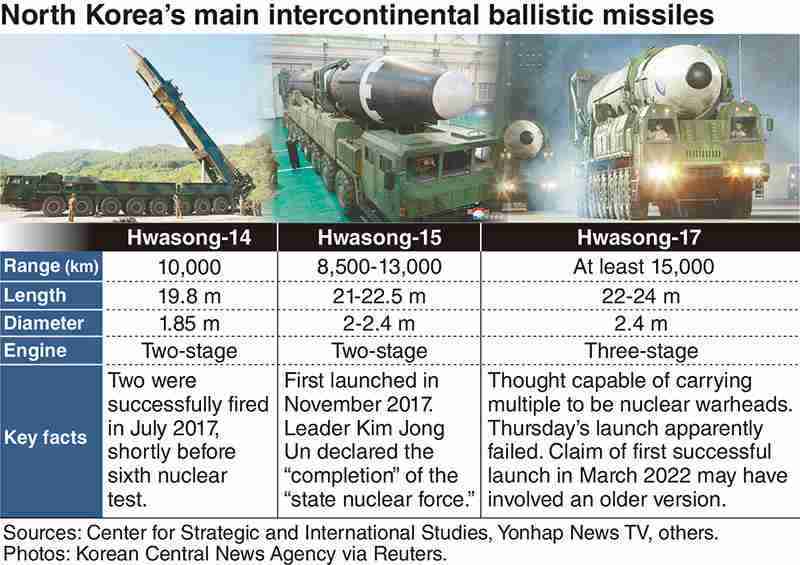
6:00 JST, November 5, 2022
SEOUL — North Korea’s latest intercontinental ballistic missile test appears to have ended in failure, but it was a clear sign that Pyongyang is expediting efforts to develop ICBMs.
The launch of what appeared to be a Hwasong-17 missile marks an escalation in North Korea’s military provocations, which it claims are retaliation for military drills being conducted jointly by South Korea and the United States.
Pyongyang’s ICBM development program is also believed to be aimed at bringing the U.S. mainland within the range of its missiles.
According to South Korean military sources, North Korea launched an ICBM in a lofted trajectory from the Sunan area of Pyongyang on Thursday morning. However, a malfunction occurred while the missile was ascending.
The fuel tank and engine separated from the three-stage missile during ascension, but it appears there was a problem with the flight of the missile after the second-stage separation. The U.S. and South Korean militaries believe the missile “failed” mid-flight.
The Hwasong-17 was first shown to the public during a military parade in October 2020. North Korean leader Kim Jong Un announced a five-year plan to develop the nation’s military capabilities at a congress of the Workers’ Party of Korea in January 2021.
Kim called for the development of an improved ICBM with a range of 15,000 kilometers, which would be capable of striking anywhere on the U.S. mainland.
The Hwasong-17, which is thought to be capable of reaching Washington D.C., could give North Korea leverage over the United States, but it appears the development of the missile is not progressing smoothly.
North Korea launched what appeared to be a Hwasong-17 from Sunan on March 16, but the missile exploded at an altitude of about 20 kilometers.
A missile fired on a lofted trajectory on March 24 reached a maximum altitude of about 6,000 kilometers. The ICBM launched Thursday only reached 1,920 kilometers.
“The Hwasong-17 definitely has a problem with its propulsion,” according to a source familiar with North Korean military technology. “The engine design will need to be changed.”
Unusually high frequency
Thursday’s launch was North Korea’s seventh of an ICBM-class missile this year. It appears Pyongyang is stepping up efforts to improve the capabilities of its missiles in a bid to achieve the objectives Kim laid out.
In addition to improving the engine, North Korea will also likely try to refine the technologies needed to achieve the difficult task of enabling a warhead to safely reenter the Earth’s atmosphere.
U.S. military experts do not believe Pyongyang’s ICBMs pose a threat to the U.S. mainland as North Korea has so far failed to demonstrate that it has the technology to achieve a successful reentry of a warhead fired on a normal trajectory.
South Korean military sources said they think North Korea will continue refining the capabilities of its ICBMs through lofted trajectory launches and then push ahead with a test on a regular trajectory.
Increasing provocations
North Korea appears to be ratcheting up tensions in the region while the United States and South Korea are heightening vigilance against Pyongyang’s provocations.
At about 2 p.m. Thursday, hours after a North Korean missile launch, the U.S. and South Korean militaries announced an extension to the ongoing Vigilant Storm joint military exercises.
Just after 8:30 p.m., Pak Jong Chon, a former chief of the General Staff of the Korean People’s Army and a secretary of the Central Committee of the Workers’ Party, denounced the decision in a statement carried by the North Korea’s official Korean Central News Agency.
“It is a very dangerous and false choice,” Pak warned and said, the United States and South Korea “will get to know what an irrevocable and awful mistake they made.”
At about 9:35 p.m., North Korea fired three short-range ballistic missiles in quick succession from North Hwanghae Province into the Sea of Japan.
Some observers believe North Korea will continue its military provocations and push ahead with preparations for a seventh nuclear test.
"Politics" POPULAR ARTICLE
-

Japan to Support Central Asian Logistics Route That Bypasses Russia, Plan to Be Part of Upcoming Summit in Tokyo
-

Japan to Tighten Screening of Foreigners’ Residential Status by Providing Information of Nonpayment of Taxes
-

Chinese, Russian Bombers Flew Unusual Path by Heading Toward Tokyo; Move Likely Meant to Intimidate Japan
-

Japan Plans National Database to Track Foreign Ownership of Real Estate, Land as It Weighs New Rules
-

Up to 199,000 Deaths Estimated From Mega-Tsunami; Most Recent Occurrence Took Place in 17th Century
JN ACCESS RANKING
-

Keidanren Chairman Yoshinobu Tsutsui Visits Kashiwazaki-Kariwa Nuclear Power Plant; Inspects New Emergency Safety System
-

Tokyo Economic Security Forum to Hold Inaugural Meeting Amid Tense Global Environment
-

Imports of Rare Earths from China Facing Delays, May Be Caused by Deterioration of Japan-China Relations
-

University of Tokyo Professor Discusses Japanese Economic Security in Interview Ahead of Forum
-

Japan Pulls out of Vietnam Nuclear Project, Complicating Hanoi’s Power Plans
























